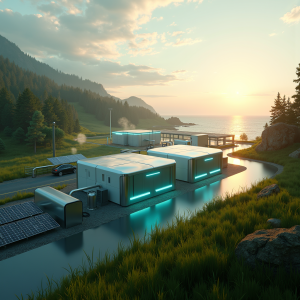Hydrogen is no longer just a future buzzword, it’s becoming one of the most exciting building blocks of clean energy systems. It’s light, storable, and when produced using renewable electricity (like solar or wind), it creates zero emissions. That’s why so many people are talking about green hydrogen, because it can power everything from heavy trucks and industrial plants to data centers and backup systems.
At the heart of this process are electrolyzers, machines that split water into hydrogen and oxygen using electricity. There are two main types: PEM (Proton Exchange Membrane), which is compact and fast-responding for solar/wind variability, and alkaline, which is cheaper and widely available. These systems are especially promising in sun-rich regions where solar power is abundant and cheap.
But hydrogen isn’t without its challenges. Storing and transporting it safely requires high-pressure tanks or cryogenic cooling, which can be complex and costly. Electrolyzers are still expensive and sensitive to impurities in water or electricity. And the overall efficiency of converting electricity to hydrogen—and then back to power—is lower than batteries, making system design critical. Scaling green hydrogen also depends on large water supply, clean energy input, and infrastructure that doesn't exist yet in many places.

At the heart of this process are electrolyzers, machines that split water into hydrogen and oxygen using electricity. There are two main types: PEM (Proton Exchange Membrane), which is compact and fast-responding for solar/wind variability, and alkaline, which is cheaper and widely available. These systems are especially promising in sun-rich regions where solar power is abundant and cheap.
But hydrogen isn’t without its challenges. Storing and transporting it safely requires high-pressure tanks or cryogenic cooling, which can be complex and costly. Electrolyzers are still expensive and sensitive to impurities in water or electricity. And the overall efficiency of converting electricity to hydrogen—and then back to power—is lower than batteries, making system design critical. Scaling green hydrogen also depends on large water supply, clean energy input, and infrastructure that doesn't exist yet in many places.

Last edited:
